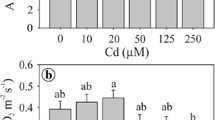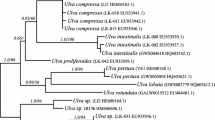Abstract
The unistratose thallus of the gemmaling of Riella helicophylla is divided into an apical growth lobe with the meristem, an intermediate pillar, and a basal rhizoidal lobe. This organization can be correlated with a distinct fluorescence pattern of wall and membrane after treatment with chlorotetracycline. Mature cells of the growth lobe are distinguished by two chlorotetracycline-binding surface regions (CSR) with a diameter of 6–12 μm in the middle of both outer cell surfaces. Meristematic cells are devoid of CSR. The same is true for cells of the pillar which elongate under low light intensity. Rhizoid initials have an enlarged CSR on the site where the rhizoidal tube will emerge, whereas the opposite cell surface lacks any chlorotetracycline fluorescence. With the beginning of the extension of the rhizoid, CSR remains as a ring around the base of the tube. Darkness, plasmolysis, and sulfhydryl reagents inhibit the fluorescence of CSR, whereas calcium antagonists in addition suppress the fluorescence of the rhizoids. Cytochemical methods demonstrate that sulfhydryl proteins and anionic polysaccharides are involved in adsorbing chlorotetracycline in this region. Surface electron-microscopic preparations reveal a local depression of the wall covered with amorphous material.
Similar content being viewed by others
Abbreviations
- APW:
-
artificial pond water
- CTC:
-
chlorotetracycline
- CSR:
-
chlorotetracycline-binding surface region
- EGTA:
-
ethylene glycol-bis(β-aminoethyl ether)-N,N,N′,N′-tetraacetic acid
- Pipes:
-
1,4-piperazine diethanesulfonic acid
References
Bowmann, B.J., Slayman, C.W. (1979) The effect of vanadate on the plasma membrane ATPase of Neurospora. J. Biol. Chem. 254, 2928–2934
Burgess, J., Linstead, P.J. (1982) Cell-wall differentiation during growth of electrically polarized protoplasts of Physcomitrella. Planta 156, 241–248
Caswell, A.H. (1979) Methods of measuring intracellular calcium. Int. Rev. Cytol. 56, 145–181
Dreyer, E.M., Weisenseel, M.H. (1979) Phytochrome mediated uptake of calcium in Mougeotia cell. Planta 146, 31–39
Grotha, R., Stange, L. (1969) Ausmaß und räumliche Verteilung der nucleolären RNS-Synthese in Gewebefragmenten von Riella nach Blockierung der DNS-Synthese. Planta 86, 324–333
Hendrix, D.L., Higinbotham, N. (1974) Heavy metals and sulphhydryl reagents as probes of ion uptake in pea stems. In: Membrane transport in plants, pp. 412–417, Zimmermann, U., Dainty, J., eds. Springer, Berlin Heidelberg New York
Jaffe, L.F. (1979) Control of development by ionic currents. In: Membrane transduction mechanisms, pp. 199–231, Cone, R.A., Dowling, J.E., eds. Raven Press, New York
Kosower, N.S., Kosower, E.M., Newton, G.L., Ranney, H.M. (1979) Bimane fluorescent labels: labeling of normal human red cells under physiological conditions. Proc. Natl. Acad. Sci. USA 76, 3382–3386
Luft, J.H. (1971) Ruthenium red and violett. I. Chemistry, purification, methods for use for electron microscopy and mechanisms of action. Anat. Rec. 171, 347–368
Meindl, U. (1982a) Local accumulation of membrane-associated calcium according to cell pattern formation in Micrasterias denticulata visualized by chlorotetracycline fluorescence. Protoplasma 110, 143–146
Meindl, U. (1982b) Patterned distribution of membrane-associated Ca2+ during pore formation in Micrasterias. Protoplasma 112, 138–141
Nakazawa, S., Tsusaki, A. (1959a) Appearance of ‘metallophilic cytoplasm’ as a prepattern to the rhizoid differentiation in fern protonema. Cytologia 24, 378–388
Nakazawa, S., Tsusaki, A. (1959b) Special cytoplasm detectable in fern rhizoids. Naturwissenschaften 46, 609–610
Nehira, K. (1973) Adsorption of Ca in the differentiation of rhizoids in gemmae of Marchantia polymorpha L. Mem. Fac. Gen. Educ. Hiroshima Univ. III, vol 7, 1–6
Nehira, K. (1982) Rhizoid formation in Marchantia gemmae. J. Hattori Bot. Lab. 53, 245–248
Novotny, A.M., Forman, M. (1974) The relationship between changes in cell wall composition and the establishment of polarity in Fucus embryos. Dev. Biol. 40, 162–173
Novotny, A.M., Forman, M. (1975) The composition and development of cell walls of Fucus embryos. Planta 122, 67–78
Pearse, A.G.E. (1968) Histochemistry, theoretical and applied, vol. 1. Churchill Livingstone, Edinburgh London New York
Quatrano, R.S. (1978) Development of cell polarity. Annu. Rev. Plant Physiol. 29, 487–510
Schult, S. (1962) Wachstum, Differenzierung und Formbildung am Brutkörper von Riella affinis. Z. Bot. 59, 417–472
Scott, J., Quintarelli, G., Dellovo, M. (1964) The chemical and histochemical properties of alcian blue. I. The mechanism of alcian blue staining. Histochemie 4, 73–85
Smith, D.L. (1972) Staining and osmotic properties of young gametophytes of Polypodium vulgare L. and their bearing on rhizoid function. Protoplasma 74, 465–479
Smith, D.L. (1979) Biochemical and physiological aspects of gametophyte differentiation and development. In: The experimental biology of ferns, pp. 355–392, Dyer, A.F., ed. Academic Press, New York London San Francisco
Stange, L. (1957) Untersuchungen über Umstimmungs- und Differenzierungsvorgänge in regenerierenden Zellen des Lebermooses Riella. Z. Bot. 45, 197–244
Studhalter, R.A., Cox, M.E. (1941) The gemma of Riella americana. Bryologist 43, 141–157
Studhalter, R.A., Cox, M.E. (1941) The gemmaling of Riella americana I. Bryologist 44, 77–93
Studhalter, R.A., Cox, M.E. (1942) The gemmaling of Riella americana II. Bryologist 45, 49–62
Viell, B. (1977) Early metabolic changes in regenerating microfragments of the liverwort Riella helicophylla (Bory et Mont.) Mont.: protein and RNA synthesis, free α-amino acid concentration. Planta 137, 13–18
Weisenseel, M.H., Nuccitelli, R., Jaffe, L.F. (1975) Large electrical currents traverse growing pollen tubes. J. Cell Biol. 66, 556–567
Weisenseel, M.H. (1979) Induction of polarity. In: Encyclopedia of plant physiology, N.S. vol. 7: Physiology of movements, pp. 485–505, Haupt, W., Feinleib, M.E., eds. Springer, Berlin Heidelberg New York
Wolniak, S.M., Hepler, P.K., Jackson, W.T. (1980) Detection of membrane-calcium distribution during mitosis in Haemanthus endosperm with chlorotetracycline. J. Cell Biol. 87, 23–32
Author information
Authors and Affiliations
Additional information
Dedicated to Professor Martin Bopp on the occasion of his 60th birthday
Rights and permissions
About this article
Cite this article
Grotha, R. Chlorotetracycline-binding surface regions in gemmalings of Riella helicophylla (Bory et Mont.) Mont.. Planta 158, 473–481 (1983). https://doi.org/10.1007/BF00397238
Received:
Accepted:
Issue Date:
DOI: https://doi.org/10.1007/BF00397238




